Maison >Applet WeChat >Développement WeChat >Illustration d'un exemple d'intégration de la connexion WeChat avec ASP.NET Core
Illustration d'un exemple d'intégration de la connexion WeChat avec ASP.NET Core
- Y2Joriginal
- 2017-04-26 14:49:265335parcourir
Cet article présente principalement les informations pertinentes sur ASP.NET Core intégrant la connexion WeChat, qui a une certaine valeur de référence. Les amis intéressés peuvent se référer aux
Outils :
. Visual Studio 2015 mise à jour 3
Asp.Net Core 1.0
1 Travail de préparation
Demander un compte de test d'interface de plateforme publique WeChat, URL de l'application : (mp.weixin.qq.com/debug/cgi-bin/sandbox?t=sandbox/login). Vous n'avez pas besoin d'un compte public pour demander un compte de test d'interface, et vous pouvez directement découvrir et tester toutes les interfaces avancées de la plateforme publique.
1.1 Configurer les informations de l'interface
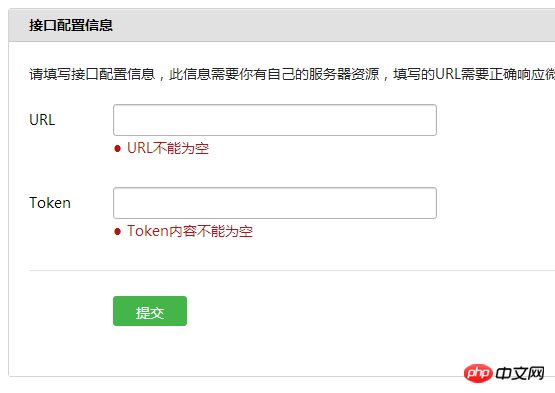
1.2 Modifier les informations d'autorisation de la page Web
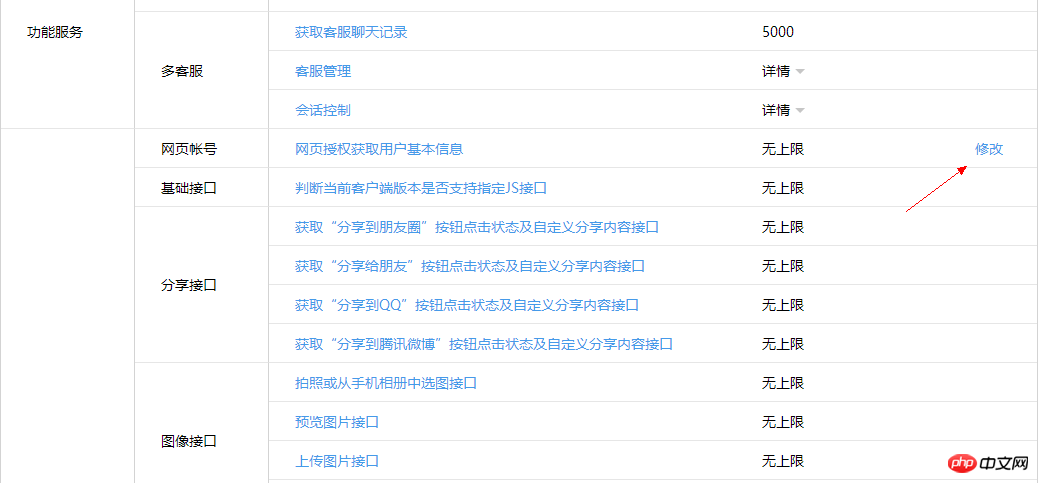
Cliquez sur "Modifier" et remplissez le nom de domaine de votre site Web sur la page pop-up :
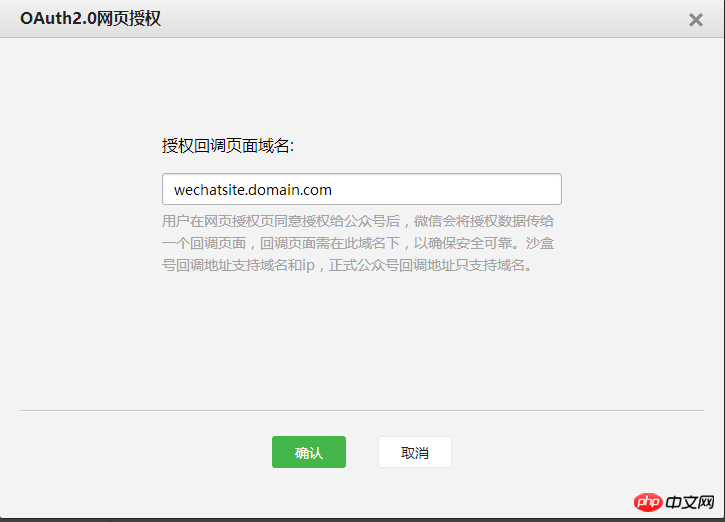
2 Créer un nouveau projet de site Web
2.1 Sélectionnez le modèle d'application Web ASP.NET Core
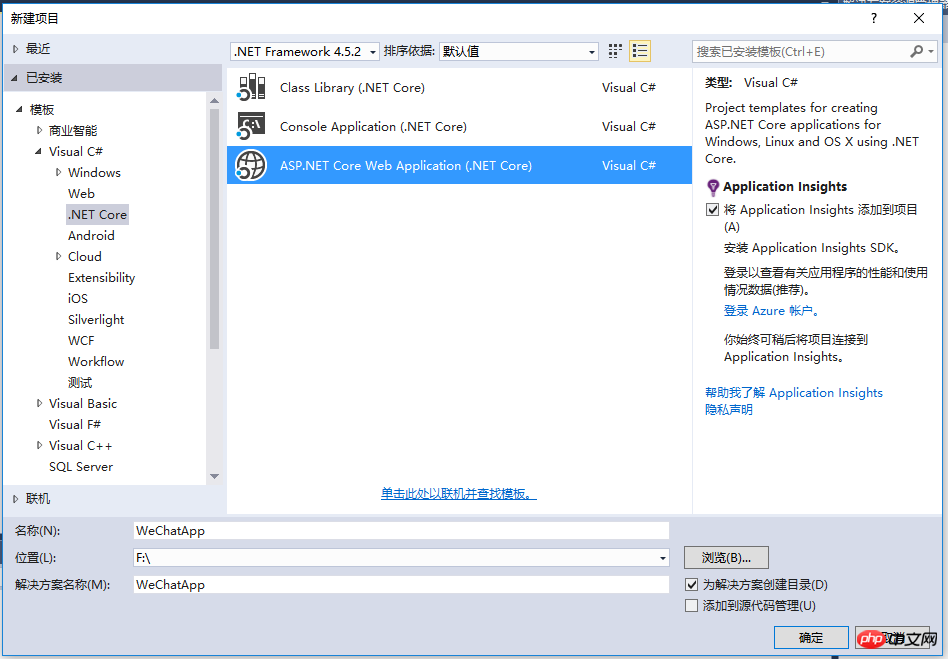
2.2 Sélectionnez l'application Web et modifiez l'authentification en compte utilisateur personnel
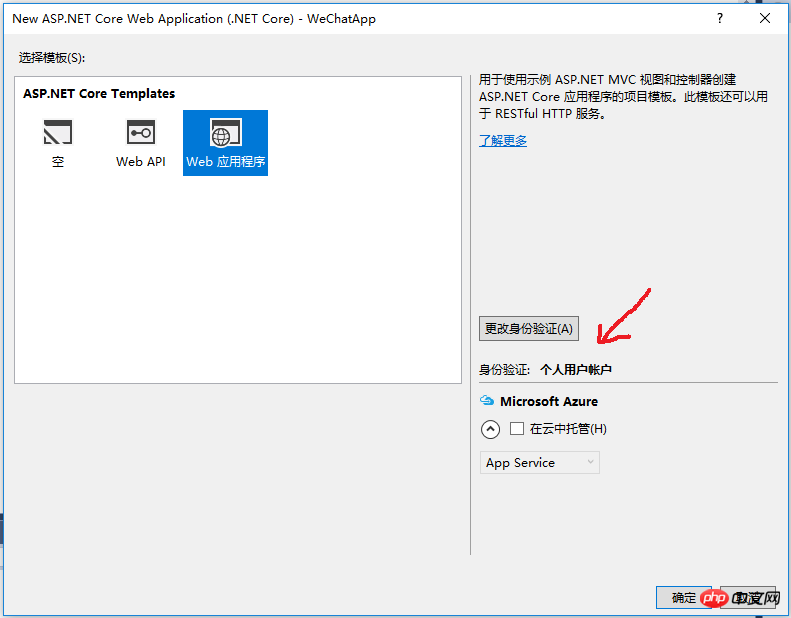
3 Intégrer la fonction de connexion WeChat
3.1 Ajouter une référence
Ouvrez le fichier project.json et ajoutez la référence Microsoft.AspNetCore.Authentication.OAuth

3.2 Ajouter des fichiers de code
Créez un nouveau dossier dans le projet, nommez-le WeChatOAuth et ajoutez le fichier de code (tous les codes sont joints à la fin de cet article).

3.3 Enregistrez le middleware de connexion WeChat
Ouvrez le fichier Startup.cs et ajoutez le code dans Configurer :
app.UseWeChatAuthentication(new WeChatOptions()
{
AppId = "******",
AppSecret = "******"
});Notez que la position d'insertion de ce code doit être en dessous de app.UseIdentity().

4 Code
:
// Copyright (c) .NET Foundation. All rights reserved.
// Licensed under the Apache License, Version 2.0. See License.txt in the project root for license information.
using System;
using Microsoft.AspNetCore.Authentication.WeChat;
using Microsoft.Extensions.Options;
namespace Microsoft.AspNetCore.Builder
{
/// <summary>
/// Extension methods to add WeChat authentication capabilities to an HTTP application pipeline.
/// </summary>
public static class WeChatAppBuilderExtensions
{
/// <summary>
/// Adds the <see cref="WeChatMiddleware"/> middleware to the specified <see cref="IApplicationBuilder"/>, which enables WeChat authentication capabilities.
/// </summary>
/// <param name="app">The <see cref="IApplicationBuilder"/> to add the middleware to.</param>
/// <returns>A reference to this instance after the operation has completed.</returns>
public static IApplicationBuilder UseWeChatAuthentication(this IApplicationBuilder app)
{
if (app == null)
{
throw new ArgumentNullException(nameof(app));
}
return app.UseMiddleware<WeChatMiddleware>();
}
/// <summary>
/// Adds the <see cref="WeChatMiddleware"/> middleware to the specified <see cref="IApplicationBuilder"/>, which enables WeChat authentication capabilities.
/// </summary>
/// <param name="app">The <see cref="IApplicationBuilder"/> to add the middleware to.</param>
/// <param name="options">A <see cref="WeChatOptions"/> that specifies options for the middleware.</param>
/// <returns>A reference to this instance after the operation has completed.</returns>
public static IApplicationBuilder UseWeChatAuthentication(this IApplicationBuilder app, WeChatOptions options)
{
if (app == null)
{
throw new ArgumentNullException(nameof(app));
}
if (options == null)
{
throw new ArgumentNullException(nameof(options));
}
return app.UseMiddleware<WeChatMiddleware>(Options.Create(options));
}
}
}WeChatDefaults.cs :
// Copyright (c) .NET Foundation. All rights reserved.
// Licensed under the Apache License, Version 2.0. See License.txt in the project root for license information.
namespace Microsoft.AspNetCore.Authentication.WeChat
{
public static class WeChatDefaults
{
public const string AuthenticationScheme = "WeChat";
public static readonly string AuthorizationEndpoint = "https://open.weixin.qq.com/connect/oauth2/authorize";
public static readonly string TokenEndpoint = "https://api.weixin.qq.com/sns/oauth2/access_token";
public static readonly string UserInformationEndpoint = "https://api.weixin.qq.com/sns/userinfo";
}
}WeChatHandler.cs
// Copyright (c) .NET Foundation. All rights reserved.
// Licensed under the Apache License, Version 2.0. See License.txt in the project root for license information.
using Microsoft.AspNetCore.Authentication.OAuth;
using Microsoft.AspNetCore.Builder;
using Microsoft.AspNetCore.Http.Authentication;
using Microsoft.AspNetCore.Http.Extensions;
using Microsoft.Extensions.Primitives;
using Newtonsoft.Json.Linq;
using System;
using System.Collections.Generic;
using System.Net.Http;
using System.Net.Http.Headers;
using System.Security.Claims;
using System.Text;
using Microsoft.AspNetCore.Mvc;
using System.Threading.Tasks;
namespace Microsoft.AspNetCore.Authentication.WeChat
{
internal class WeChatHandler : OAuthHandler<WeChatOptions>
{
public WeChatHandler(HttpClient httpClient)
: base(httpClient)
{
}
protected override async Task<AuthenticateResult> HandleRemoteAuthenticateAsync()
{
AuthenticationProperties properties = null;
var query = Request.Query;
var error = query["error"];
if (!StringValues.IsNullOrEmpty(error))
{
var failureMessage = new StringBuilder();
failureMessage.Append(error);
var errorDescription = query["error_description"];
if (!StringValues.IsNullOrEmpty(errorDescription))
{
failureMessage.Append(";Description=").Append(errorDescription);
}
var errorUri = query["error_uri"];
if (!StringValues.IsNullOrEmpty(errorUri))
{
failureMessage.Append(";Uri=").Append(errorUri);
}
return AuthenticateResult.Fail(failureMessage.ToString());
}
var code = query["code"];
var state = query["state"];
var oauthState = query["oauthstate"];
properties = Options.StateDataFormat.Unprotect(oauthState);
if (state != Options.StateAddition || properties == null)
{
return AuthenticateResult.Fail("The oauth state was missing or invalid.");
}
// OAuth2 10.12 CSRF
if (!ValidateCorrelationId(properties))
{
return AuthenticateResult.Fail("Correlation failed.");
}
if (StringValues.IsNullOrEmpty(code))
{
return AuthenticateResult.Fail("Code was not found.");
}
//获取tokens
var tokens = await ExchangeCodeAsync(code, BuildRedirectUri(Options.CallbackPath));
var identity = new ClaimsIdentity(Options.ClaimsIssuer);
AuthenticationTicket ticket = null;
if (Options.WeChatScope == Options.InfoScope)
{
//获取用户信息
ticket = await CreateTicketAsync(identity, properties, tokens);
}
else
{
//不获取信息,只使用openid
identity.AddClaim(new Claim(ClaimTypes.NameIdentifier, tokens.TokenType, ClaimValueTypes.String, Options.ClaimsIssuer));
ticket = new AuthenticationTicket(new ClaimsPrincipal(identity), properties, Options.AuthenticationScheme);
}
if (ticket != null)
{
return AuthenticateResult.Success(ticket);
}
else
{
return AuthenticateResult.Fail("Failed to retrieve user information from remote server.");
}
}
/// <summary>
/// OAuth第一步,获取code
/// </summary>
/// <param name="properties"></param>
/// <param name="redirectUri"></param>
/// <returns></returns>
protected override string BuildChallengeUrl(AuthenticationProperties properties, string redirectUri)
{
//加密OAuth状态
var oauthstate = Options.StateDataFormat.Protect(properties);
//
redirectUri = $"{redirectUri}?{nameof(oauthstate)}={oauthstate}";
var queryBuilder = new QueryBuilder()
{
{ "appid", Options.ClientId },
{ "redirect_uri", redirectUri },
{ "response_type", "code" },
{ "scope", Options.WeChatScope },
{ "state", Options.StateAddition },
};
return Options.AuthorizationEndpoint + queryBuilder.ToString();
}
/// <summary>
/// OAuth第二步,获取token
/// </summary>
/// <param name="code"></param>
/// <param name="redirectUri"></param>
/// <returns></returns>
protected override async Task<OAuthTokenResponse> ExchangeCodeAsync(string code, string redirectUri)
{
var tokenRequestParameters = new Dictionary<string, string>()
{
{ "appid", Options.ClientId },
{ "secret", Options.ClientSecret },
{ "code", code },
{ "grant_type", "authorization_code" },
};
var requestContent = new FormUrlEncodedContent(tokenRequestParameters);
var requestMessage = new HttpRequestMessage(HttpMethod.Post, Options.TokenEndpoint);
requestMessage.Headers.Accept.Add(new MediaTypeWithQualityHeaderValue("application/json"));
requestMessage.Content = requestContent;
var response = await Backchannel.SendAsync(requestMessage, Context.RequestAborted);
if (response.IsSuccessStatusCode)
{
var payload = JObject.Parse(await response.Content.ReadAsStringAsync());
string ErrCode = payload.Value<string>("errcode");
string ErrMsg = payload.Value<string>("errmsg");
if (!string.IsNullOrEmpty(ErrCode) | !string.IsNullOrEmpty(ErrMsg))
{
return OAuthTokenResponse.Failed(new Exception($"ErrCode:{ErrCode},ErrMsg:{ErrMsg}"));
}
var tokens = OAuthTokenResponse.Success(payload);
//借用TokenType属性保存openid
tokens.TokenType = payload.Value<string>("openid");
return tokens;
}
else
{
var error = "OAuth token endpoint failure";
return OAuthTokenResponse.Failed(new Exception(error));
}
}
/// <summary>
/// OAuth第四步,获取用户信息
/// </summary>
/// <param name="identity"></param>
/// <param name="properties"></param>
/// <param name="tokens"></param>
/// <returns></returns>
protected override async Task<AuthenticationTicket> CreateTicketAsync(ClaimsIdentity identity, AuthenticationProperties properties, OAuthTokenResponse tokens)
{
var queryBuilder = new QueryBuilder()
{
{ "access_token", tokens.AccessToken },
{ "openid", tokens.TokenType },//在第二步中,openid被存入TokenType属性
{ "lang", "zh_CN" }
};
var infoRequest = Options.UserInformationEndpoint + queryBuilder.ToString();
var response = await Backchannel.GetAsync(infoRequest, Context.RequestAborted);
if (!response.IsSuccessStatusCode)
{
throw new HttpRequestException($"Failed to retrieve WeChat user information ({response.StatusCode}) Please check if the authentication information is correct and the corresponding WeChat Graph API is enabled.");
}
var user = JObject.Parse(await response.Content.ReadAsStringAsync());
var ticket = new AuthenticationTicket(new ClaimsPrincipal(identity), properties, Options.AuthenticationScheme);
var context = new OAuthCreatingTicketContext(ticket, Context, Options, Backchannel, tokens, user);
var identifier = user.Value<string>("openid");
if (!string.IsNullOrEmpty(identifier))
{
identity.AddClaim(new Claim(ClaimTypes.NameIdentifier, identifier, ClaimValueTypes.String, Options.ClaimsIssuer));
}
var nickname = user.Value<string>("nickname");
if (!string.IsNullOrEmpty(nickname))
{
identity.AddClaim(new Claim(ClaimTypes.Name, nickname, ClaimValueTypes.String, Options.ClaimsIssuer));
}
var sex = user.Value<string>("sex");
if (!string.IsNullOrEmpty(sex))
{
identity.AddClaim(new Claim("urn:WeChat:sex", sex, ClaimValueTypes.String, Options.ClaimsIssuer));
}
var country = user.Value<string>("country");
if (!string.IsNullOrEmpty(country))
{
identity.AddClaim(new Claim(ClaimTypes.Country, country, ClaimValueTypes.String, Options.ClaimsIssuer));
}
var province = user.Value<string>("province");
if (!string.IsNullOrEmpty(province))
{
identity.AddClaim(new Claim(ClaimTypes.StateOrProvince, province, ClaimValueTypes.String, Options.ClaimsIssuer));
}
var city = user.Value<string>("city");
if (!string.IsNullOrEmpty(city))
{
identity.AddClaim(new Claim("urn:WeChat:city", city, ClaimValueTypes.String, Options.ClaimsIssuer));
}
var headimgurl = user.Value<string>("headimgurl");
if (!string.IsNullOrEmpty(headimgurl))
{
identity.AddClaim(new Claim("urn:WeChat:headimgurl", headimgurl, ClaimValueTypes.String, Options.ClaimsIssuer));
}
var unionid = user.Value<string>("unionid");
if (!string.IsNullOrEmpty(unionid))
{
identity.AddClaim(new Claim("urn:WeChat:unionid", unionid, ClaimValueTypes.String, Options.ClaimsIssuer));
}
await Options.Events.CreatingTicket(context);
return context.Ticket;
}
}
}WeChatMiddleware.cs
// Copyright (c) .NET Foundation. All rights reserved.
// Licensed under the Apache License, Version 2.0. See License.txt in the project root for license information.
using System;
using System.Globalization;
using System.Text.Encodings.Web;
using Microsoft.AspNetCore.Authentication.OAuth;
using Microsoft.AspNetCore.Builder;
using Microsoft.AspNetCore.DataProtection;
using Microsoft.AspNetCore.Http;
using Microsoft.Extensions.Logging;
using Microsoft.Extensions.Options;
namespace Microsoft.AspNetCore.Authentication.WeChat
{
/// <summary>
/// An ASP.NET Core middleware for authenticating users using WeChat.
/// </summary>
public class WeChatMiddleware : OAuthMiddleware<WeChatOptions>
{
/// <summary>
/// Initializes a new <see cref="WeChatMiddleware"/>.
/// </summary>
/// <param name="next">The next middleware in the HTTP pipeline to invoke.</param>
/// <param name="dataProtectionProvider"></param>
/// <param name="loggerFactory"></param>
/// <param name="encoder"></param>
/// <param name="sharedOptions"></param>
/// <param name="options">Configuration options for the middleware.</param>
public WeChatMiddleware(
RequestDelegate next,
IDataProtectionProvider dataProtectionProvider,
ILoggerFactory loggerFactory,
UrlEncoder encoder,
IOptions<SharedAuthenticationOptions> sharedOptions,
IOptions<WeChatOptions> options)
: base(next, dataProtectionProvider, loggerFactory, encoder, sharedOptions, options)
{
if (next == null)
{
throw new ArgumentNullException(nameof(next));
}
if (dataProtectionProvider == null)
{
throw new ArgumentNullException(nameof(dataProtectionProvider));
}
if (loggerFactory == null)
{
throw new ArgumentNullException(nameof(loggerFactory));
}
if (encoder == null)
{
throw new ArgumentNullException(nameof(encoder));
}
if (sharedOptions == null)
{
throw new ArgumentNullException(nameof(sharedOptions));
}
if (options == null)
{
throw new ArgumentNullException(nameof(options));
}
if (string.IsNullOrEmpty(Options.AppId))
{
throw new ArgumentException(string.Format(CultureInfo.CurrentCulture, nameof(Options.AppId)));
}
if (string.IsNullOrEmpty(Options.AppSecret))
{
throw new ArgumentException(string.Format(CultureInfo.CurrentCulture, nameof(Options.AppSecret)));
}
}
/// <summary>
/// Provides the <see cref="AuthenticationHandler{T}"/> object for processing authentication-related requests.
/// </summary>
/// <returns>An <see cref="AuthenticationHandler{T}"/> configured with the <see cref="WeChatOptions"/> supplied to the constructor.</returns>
protected override AuthenticationHandler<WeChatOptions> CreateHandler()
{
return new WeChatHandler(Backchannel);
}
}
}WeChatOptions.cs
// Copyright (c) .NET Foundation. All rights reserved.
// Licensed under the Apache License, Version 2.0. See License.txt in the project root for license information.
using System.Collections.Generic;
using Microsoft.AspNetCore.Authentication.WeChat;
using Microsoft.AspNetCore.Http;
using Microsoft.AspNetCore.Identity;
namespace Microsoft.AspNetCore.Builder
{
/// <summary>
/// Configuration options for <see cref="WeChatMiddleware"/>.
/// </summary>
public class WeChatOptions : OAuthOptions
{
/// <summary>
/// Initializes a new <see cref="WeChatOptions"/>.
/// </summary>
public WeChatOptions()
{
AuthenticationScheme = WeChatDefaults.AuthenticationScheme;
DisplayName = AuthenticationScheme;
CallbackPath = new PathString("/signin-wechat");
StateAddition = "#wechat_redirect";
AuthorizationEndpoint = WeChatDefaults.AuthorizationEndpoint;
TokenEndpoint = WeChatDefaults.TokenEndpoint;
UserInformationEndpoint = WeChatDefaults.UserInformationEndpoint;
//SaveTokens = true;
//BaseScope (不弹出授权页面,直接跳转,只能获取用户openid),
//InfoScope (弹出授权页面,可通过openid拿到昵称、性别、所在地。并且,即使在未关注的情况下,只要用户授权,也能获取其信息)
WeChatScope = InfoScope;
}
// WeChat uses a non-standard term for this field.
/// <summary>
/// Gets or sets the WeChat-assigned appId.
/// </summary>
public string AppId
{
get { return ClientId; }
set { ClientId = value; }
}
// WeChat uses a non-standard term for this field.
/// <summary>
/// Gets or sets the WeChat-assigned app secret.
/// </summary>
public string AppSecret
{
get { return ClientSecret; }
set { ClientSecret = value; }
}
public string StateAddition { get; set; }
public string WeChatScope { get; set; }
public string BaseScope = "snsapi_base";
public string InfoScope = "snsapi_userinfo";
}
}Ce qui précède est le contenu détaillé de. pour plus d'informations, suivez d'autres articles connexes sur le site Web de PHP en chinois!
Articles Liés
Voir plus- Explication détaillée et utilisation simple de la zone de texte du mini programme WeChat
- Développement de compte public PHP WeChat (2) Construction de Baidu BAE et utilisation de la base de données
- php Développement de compte public WeChat (3) php implémente une communication textuelle simple WeChat
- Développement de compte public php WeChat (4) php implémente des réponses de mots clés personnalisées
- Version PHP du magasin WeChat appelant un exemple de code API

